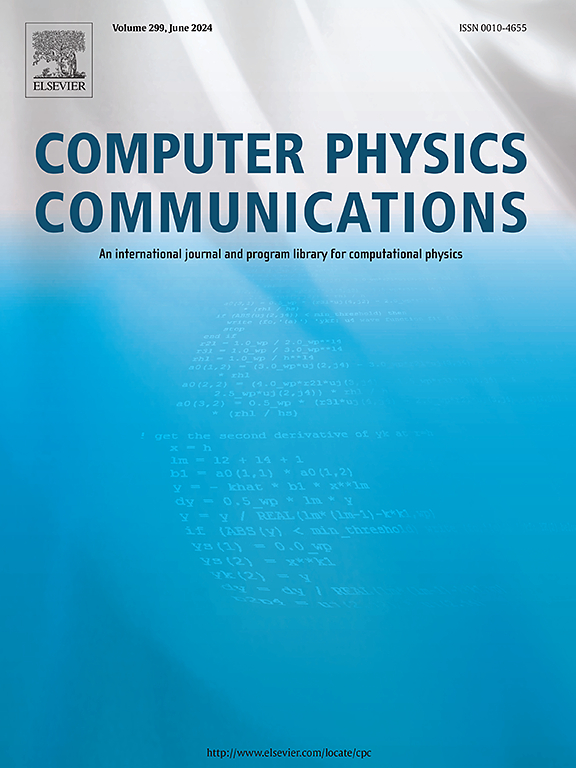SSLG4: Geant4 的新型闪烁体模拟库
IF 7.2
2区 物理与天体物理
Q1 COMPUTER SCIENCE, INTERDISCIPLINARY APPLICATIONS
引用次数: 0
摘要
本研究为 Geant4 蒙特卡罗模拟软件包引入了一个名为 SSLG4 的新闪烁体模拟库。通过 SSLG4,我们旨在简化闪烁体处理并提供丰富的闪烁体资源库,从而在 Geant4 框架内提高光学模拟的效率并加快进度。通过 SSLG4,用户可以快速将预定义的闪烁体材料纳入仿真,而无需手动定义。闪烁体库最初包含 68 种闪烁体,包括 58 种有机闪烁体和 10 种无机闪烁体。这些闪烁体大多选自几家闪烁体制造商的产品目录,特别是 Eljen 和 Luxium。其他闪烁体则是根据其在不同物理领域的广泛应用而纳入其中的。该库将闪烁体的光学数据存储在以 .mac 和 .txt 为扩展名的 ASCII 文件中,使用户能够在应用程序运行时添加、删除或修改闪烁体的属性。此外,我们还在网站的专门页面上提供了该库中的所有闪烁体数据,以确保所有用户都能方便地访问:SSLG4CPC 库程序文件链接:https://doi.org/10.17632/3zbwr5wf7z.1Developer's repository 链接:https://github.com/mkandemirr/SSLG4, https://neutrino.erciyes.edu.tr/SSLG4/Licensing 规定:GNU General Public License 3编程语言:C++外部例程/库:Geant4、CMake、OPSim问题性质:在 Geant4 中定义新的闪烁体对某些用户来说是一个繁琐的过程,主要原因有三:(1) 需要用户输入大量数据;(2) 收集闪烁体数据需要查阅大量文献;(3) 需要将收集到的数据转换成所需的格式。此外,定义闪烁体所提供的接口会引导用户将闪烁体数据嵌入源代码中,导致代码复杂度增加,代码可读性降低,工作环境效率低下:为解决上述问题,开发并引入一个由完全参数化且随时可用的闪烁体组成的新库,将大大提高 Geant4 仿真软件包在闪烁体研究方面的可用性,并引起科学界的广泛兴趣。本文章由计算机程序翻译,如有差异,请以英文原文为准。
SSLG4: A novel scintillator simulation library for Geant4
This study introduces a new Scintillator Simulation Library called SSLG4 for the Geant4 Monte Carlo simulation package. With SSLG4, we aim to enhance efficiency and accelerate progress in optical simulations within the Geant4 framework by simplifying scintillator handling and providing a rich repository of scintillators. The SSLG4 enables users to quickly include predefined scintillator materials in their simulations without requiring manual definition. The library initially contains 68 scintillators, consisting of 58 organic and 10 inorganic types. Most of these scintillators are selected from the catalogs of several scintillator manufacturers, notably Eljen and Luxium. Other scintillators are included based on their widespread use across various physics domains. The library stores optical data of scintillators in ASCII files with .mac and .txt extensions, enabling users to add, remove, or modify properties of scintillators at runtime of their applications. In addition, we made all the scintillator data available in the library on a dedicated page of our website to ensure convenient access for all users.
Program summary
Program title: SSLG4
CPC Library link to program files: https://doi.org/10.17632/3zbwr5wf7z.1
Developer's repository link: https://github.com/mkandemirr/SSLG4, https://neutrino.erciyes.edu.tr/SSLG4/
Licensing provisions: GNU General Public License 3
Programming language: C++
External routines/libraries: Geant4, CMake, OPSim
Nature of problem: Defining a new scintillator in Geant4 is a cumbersome process for some users due to three main reasons: (1) It requires a lot of data input from users, (2) collecting the scintillator data requires an extensive literature review, and (3) the collected data needs to be converted into the desired format. In addition, the interfaces provided to define a scintillator direct users to embed scintillator data into their source code, resulting in increased code complexity, reduced code readability, and an inefficient working environment.
Solution method: To solve the problems mentioned above, developing and introducing a new library consisting of fully parameterized and ready-to-use scintillators would greatly increase the useability of the Geant4 simulation package for scintillator studies and interest a wide range of scientific communities.
求助全文
通过发布文献求助,成功后即可免费获取论文全文。
去求助
来源期刊

Computer Physics Communications
物理-计算机:跨学科应用
CiteScore
12.10
自引率
3.20%
发文量
287
审稿时长
5.3 months
期刊介绍:
The focus of CPC is on contemporary computational methods and techniques and their implementation, the effectiveness of which will normally be evidenced by the author(s) within the context of a substantive problem in physics. Within this setting CPC publishes two types of paper.
Computer Programs in Physics (CPiP)
These papers describe significant computer programs to be archived in the CPC Program Library which is held in the Mendeley Data repository. The submitted software must be covered by an approved open source licence. Papers and associated computer programs that address a problem of contemporary interest in physics that cannot be solved by current software are particularly encouraged.
Computational Physics Papers (CP)
These are research papers in, but are not limited to, the following themes across computational physics and related disciplines.
mathematical and numerical methods and algorithms;
computational models including those associated with the design, control and analysis of experiments; and
algebraic computation.
Each will normally include software implementation and performance details. The software implementation should, ideally, be available via GitHub, Zenodo or an institutional repository.In addition, research papers on the impact of advanced computer architecture and special purpose computers on computing in the physical sciences and software topics related to, and of importance in, the physical sciences may be considered.
 求助内容:
求助内容: 应助结果提醒方式:
应助结果提醒方式:


